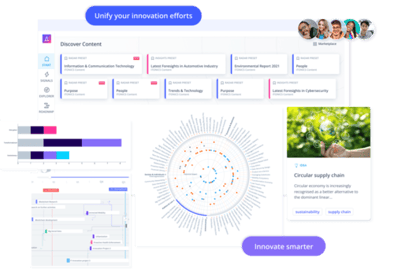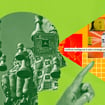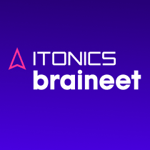Digital transformation is imperative to doing business today. It enables organizations to increase productivity, streamline operations, and respond to customers’ ever-changing needs. It is becoming a requisite for resilience and success in an increasingly uncertain future and the catalyst for economic growth on a global scale. And integral to this digital transformation is the information and communication technology (ICT) industry.
The imperative for digitalization across all sectors has pushed the ICT industry to develop new technologies, products, and services at an unprecedented pace while attracting new investment, talent, and players to the market. Demand for flexibility, affordability, and accessibility of ICTs continues to rise while there is a persistent need for greater computing power and cybersecurity. These forces drive innovation and new approaches to value chains and business models in the industry. Moreover, with the potential to shape the future of work, bridge the digital divide, and spark economic development, ICT is itself a driving force.
In this blog, we’ll present some of the forces shaping the future of the ICT industry, along with the key trends, game-changing technologies, and practical industry applications, highlighting how organizations are finding and leveraging innovative opportunities.
Forces shaping the future of the ICT industry
1. Decentralized technology
It is the age of decentralized technology. Since its roots in the creation of Bitcoin and the first blockchain in 2008, decentralized technologies and, specifically, distributed ledger technologies (DLTs) have branched off from digital currencies and other forms of decentralized finance (DeFi) to a wide range of decentralized applications (dApps) and systems used across industries.
There is growing interest in decentralized autonomous organizations (DAOs) as a transparent and open-source blockchain-based governing structure for crypto exchanges, venture capital, fundraising, and even virtual worlds. New, increasingly practical use cases are also emerging for DLTs, including supply chain traceability and Distributed Manufacturing, authentication of Digital Assets and Metaverse Commerce, and secure Data Ownership.
This progression represents a growing trend towards ICT decentralization, in general, and shifting control away from big tech firms. While decentralization may not be right for every business model, its advantages—improved security, greater transparency, and reduced dependence on a single point of control or failure—are attracting many converts. Leveraging these advantages has also given rise to the concept of Web 3.0. Referred to as the next iteration of the internet, Web 3.0 aims to create a more equitable, inclusive, and open internet, where users have greater control over their data and privacy and where information and value can be exchanged in a more secure and transparent manner.
|
2. Democratization of technology
The democratization of technology is underway as the knowledge and capabilities surrounding high-tech platforms become more accessible. Open-source and modular ICT tools like Low-Code No-Code Platforms and concepts like AI For Everbody and the API Economy are democratizing product development, changing how organizations deploy ICT applications, allocate resources, and manage teams. This shift empowers citizen developers and non-technical individuals to design solutions incorporating their unique perspectives or expertise. Advantages include greater agility, faster development cycles, and reduced time to market.
Democratization of technology can help bridge the skills gap and drive New Talent Strategies as organizations seek to digitalize their processes and product offerings. It can enable smaller and varied organizations to augment their ICT capabilities to compete with incumbents and create an environment that supports grassroots innovation, practically and culturally, within an organization.
Tech inclusion also speaks to the trend of Democratization of Education, which is driven by the proliferation of global internet access and the steep rise in e-learning platforms following the pandemic. Growing demand for technical skills to support digital transformation and the future of work has resulted in more accessible learning channels that cater to personalized needs, such as specific topics, tech applications, or ICT roles.
|
3. Issues of digital parity
Despite many ICTs becoming more accessible, the effects of digital parity are sharper than ever. These are the tools that enable digital transformation, and without them, businesses, economies, and society are at a huge disadvantage. Enhancing ICT access and capabilities is especially important for developing economies where there are opportunities to leapfrog industrial-age infrastructure. The ICT industry must play a role in investigating new technologies and services that address the digital divide by, at minimum, improving internet penetration and, at best, providing practical hardware, software, and skills training.
Internet-insecure nations with low digital literacy rates will benefit greatly from advancements that make ICT infrastructure more cost-effective, scalable, and easy to use. This includes 5G Mobile Network rollout (and future 6G development) and improved satellite connectivity through low Earth orbit (LEO) and Nanosatellites.
However, achieving Digital Equality is a complex challenge, and solutions must be implemented with an understanding of the economic, social, and cultural factors that have contributed to the divide. For ICT companies entering developing countries, where Big Tech Regulation may be immature, taking a stance to uphold Data Ethics and other ESG standards will be a key differentiator.
|
4. Autonomous things and more
The automation of things, processes, and functions is continuously expanding and developing, promising enhanced efficiency and precision, improved safety, better decision-making, and reduced labor costs. Thanks to advances in Machine Learning (ML), automation is sweeping through industries and influencing the market for both ICT hardware and software.
The availability of low-cost, low-power sensors and wireless communication technologies combined with advancements in Edge Computing have given rise to the Internet of Autonomous Things, or simply autonomous things (AuT), and the Internet of Thinking. AuT encompasses various devices, such as autonomous vehicles and vessels and intelligent machines like home appliances, industrial equipment, and robots. Meanwhile, breakthroughs in generative and Creative AI and autonomous systems like Self-Adaptive Security are expected to have a transformative impact on many industries and applications.
Promising enhanced efficiency and precision, improved safety, better decision-making, and reduced labor costs, automation will likely become central to the functioning of many businesses. It has the ability to optimize value chains and usher in Green and Lean strategies. Automating a Greener World and transitioning to Smart Cities will likewise require automation, giving rise to the burgeoning market of cleantech.
|
5. Toward zero UI
The use of touchless technology is accelerating and, in many instances, replacing touchscreens and shared devices. This is facilitating the move to zero user interface (UI) that requires little or no physical or visual interaction from users. Instead, it relies on voice commands, gestures, or sensors to operate, with the goal of making the technology seamless and invisible to the user.
These new control interfaces rely on breakthroughs in image recognition and computer vision, Natural Language Processing, Gaze Detection Technology, and Facial Recognition and Biometrics. Examples of zero UI technologies include Conversational Systems, smart home appliances, and Brain-Computer Interfaces.
Zero UI represents a step toward creating more natural and intuitive ways for people to interact with technology. It offers increased accessibility and inclusivity for more people, especially individuals with disabilities or impairments that make it challenging to use traditional interfaces. The applications for zero UI are expected to continue to expand in step with Low-Touch Living, Hybrid Engagement, and Extended Reality.
|
6. The shift to hybrid cloud
More organizations are adopting a cloud infrastructure, drawn to the cost savings, flexibility, and scalability that cloud-based technologies offer. Hybrid cloud strategies, in particular, promise the best of both worlds, with a combination of Product-as-a-Service (PaaS) applications and on-premise data centers. Hybrid cloud allows organizations to work across multiple computing environments and manage exponential data growth while ensuring security, privacy, and compliance. Large public cloud providers are pouring investments into hybrid solutions, and there is a wave of new PaaS business models.
ICT companies are leading this shift, prioritizing cloud-based solutions in their own businesses, followed by on-premise solutions where needed. Hybrid cloud optimizes data management amidst the growing implementation of IoT and other data-intensive systems. Hyper-Converged Infrastructure supports this approach by providing a structured, cost-effective, and secure environment for cloud expansion.
Indeed, as companies shift their operations to the cloud, there is a growing need for integrating end-to-end security and compliance into the entire IT lifecycle. Employing DevSecOps makes security a shared responsibility, breaking down traditional silos between development and security teams and enabling the trend Data Secure by Design.
|
Finding innovation opportunities in the ICT industry
Get started by exploring the ITONICS ICT Trend Radar and ICT Technology Radar, displaying the drivers of change that are most relevant to the information and communication technology industry. Here you can deep dive into the implications for innovation associated with each driver, compare drivers across different rating criteria, and view related examples of real-world innovation that address emerging needs and provide novel solutions.
If you want to further evaluate the impact and relevance of these trends and technologies for your business, kick-start your innovation journey on the ITONICS Innovation OS today.
For more information, check out the ICT Industry Use Case outlining how the ITONICS Innovation OS can help you navigate the forces shaping the future, anticipate the most rewarding opportunities, and take decisive action toward achieving your innovation goals.

Get started with the ITONICS Innovation OS
Have more time?

/Assets%20and%20Heros/nav-thumbnail-toyota.webp?width=150&name=nav-thumbnail-toyota.webp)









